People:
Joseph Pawlik
Graduate students
Information for undergrads and
prospective grad students
Science:
Marine chemical ecology
Giant barrel sponge Xestospongia muta
Marine invertebrate larval
biology
Photographic guide to sponges of the Caribbean
Courses:
BIO 318:
Invertebrate
Zoology
BIO 501: Science as a Profession
| HOME |
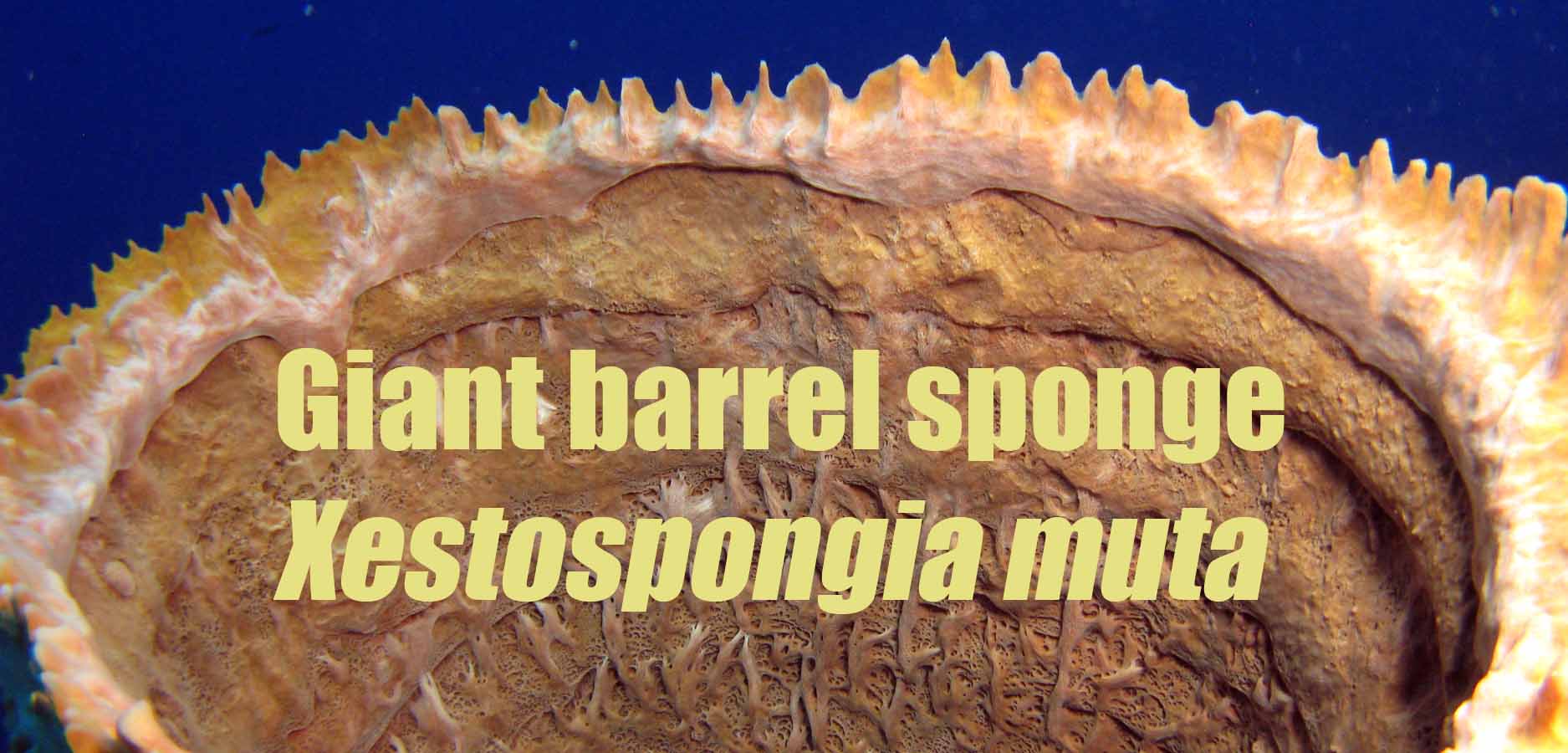
Bleaching in Xestospongia muta:
Tissues of X. muta contain cyanobacterial symbionts belonging to the Synechococcus-Prochlorococcus clade (Gómez et al. 2004; Steindler et al. 2005) that impart the reddish-brown to brown-gray coloration to the sponge. In addition, the cyanobacteria may be responsible for the translocation of carbon, nitrogen and phosphorous to the host sponge (Wilkinson 1983) which likely enhances sponge growth (Thacker 2005).
|
|
Reports of bleaching, or loss of pigmentation, of X. muta, along with other symbiont-containing sponges, began to appear along with reports of coral bleaching events over a decade ago (Vincente 1990). In some cases, bleached sponges deteriorated and disintegrated; moreover, bleached X. muta were more susceptible to predation by parrotfishes and generalist predators (Dunlap & Pawlik 1998). |
Bleaching and subsequent mortality has since been observed throughout the Caribbean (Nagelkerken et al. 2000) and has also been reported for an analogous species, Xestospongia testudinaria, on reefs in Australia. To date, there has been no systematic investigation of mortality due to sponge bleaching, or its impact on sponge distributions and abundances.
Cyclic Bleaching:
We have observed regular bleaching of X. muta at all our transect sites.
Sponges may only become pale, or at the extreme, nearly completely white. Cyclic
bleaching is common, affecting as many as 86% of the sponges within transects
during a given sampling period, although adjacent sponges are often dissimilarly
affected. Cyclic bleaching is usually not fatal and sponges recover over time.
Many of the sponges within our study sites exhibit intense bleaching during the
fall but had recovered their pigmentation by the following spring. Sponge AFL,
below, was bleached in October 2000 and had recovered seven months later.
Another example, sponge ABH also exhibited bleaching and recovery within two
survey periods.
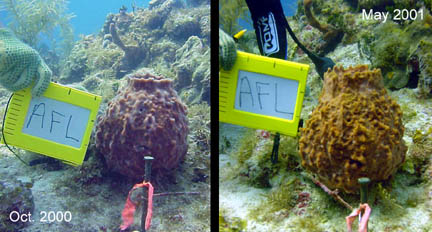
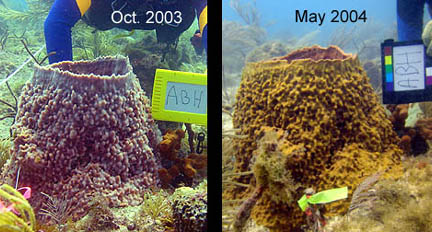
The cause of cyclic bleaching in X. muta remains unclear. Bleaching is less prevalent in sponges at shallow sites, suggesting that high seawater temperatures are not responsible. Some evidence suggests that cyclic bleaching may be tied to post-reproductive stress.
Fatal Bleaching:
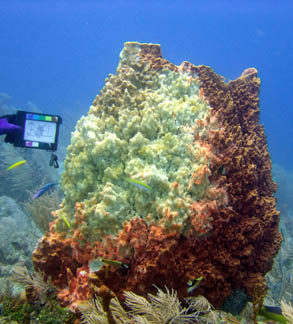 Fatal bleaching appears to
be a separate phenomenon from cyclic bleaching. Fatal bleaching is a
complete whitening of sponge tissue and results in large amounts of tissue loss
or complete sponge mortality.
Fatal bleaching appears to
be a separate phenomenon from cyclic bleaching. Fatal bleaching is a
complete whitening of sponge tissue and results in large amounts of tissue loss
or complete sponge mortality.
Fatal bleaching has been associated with a distinctive “orange band” separating mildly bleached and completely bleached portions of tissue as the syndrome progresses. Tissues of fatally bleached sponges are vigorously consumed by both spongivorous and generalist predatory fishes (Dunlap & Pawlik 1998). "Sponge orange-band" (SOB) syndrome may be a very extreme form of cyclic bleaching, but more likely is associated with pathogenesis. We are working with collaborators to further investigate fatal bleaching.
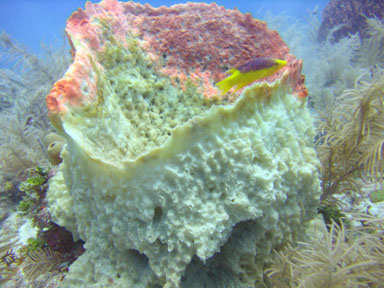
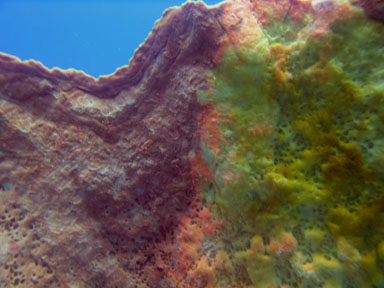
References:
- Dunlap, M., Pawlik, J.R. 1998. Spongivory by parrotfishes in Florida mangrove and reef habitats. Mar. Ecol. PSZNI 19:325-337.
- Gómez, R., Erpenbeck, D., Van Dijk, T., Richelle-Maurer, E., Devijver, C., Braekman, J.C., Woldringh, C., Van Soest, R.W.M. 2004. Identity of cyanobacterial symbionts of Xestospongia muta. Boll. Mus. Ist. Biol. Univ. Genova 66-67: 82-83
- Nagelkerken, I., Aerts, L., Pors, L. 2000. Barrel sponge bows out. Reef Encounter 28:14-15.
- Steindler, L. Hucheon, D, Avni, A, Ilan, M. 2005. 16S rRNA phylogeny of sponge associated cyanobacteria. App. Environ. Microbiol. 71:4127-4131
- Thacker, R.W. 2005. Impacts of shading on sponge-cyanobateria symbioses: a comparison between host-specific and generalist associations. Integr. Comp. Biol. 45: 369-376.
- Vincente, V.P. 1990. Response of sponges with autotrophic endosymbionts during the coral-bleaching episode in Puerto Rico (West Indies). Coral Reefs 8: 199-202.
- Wilkinson, C.R. 1983a. Net primary productivity in coral reef sponges. Science 219:410-411
X. muta | Population Dynamics | Bleaching | Monofilament Line | Age

